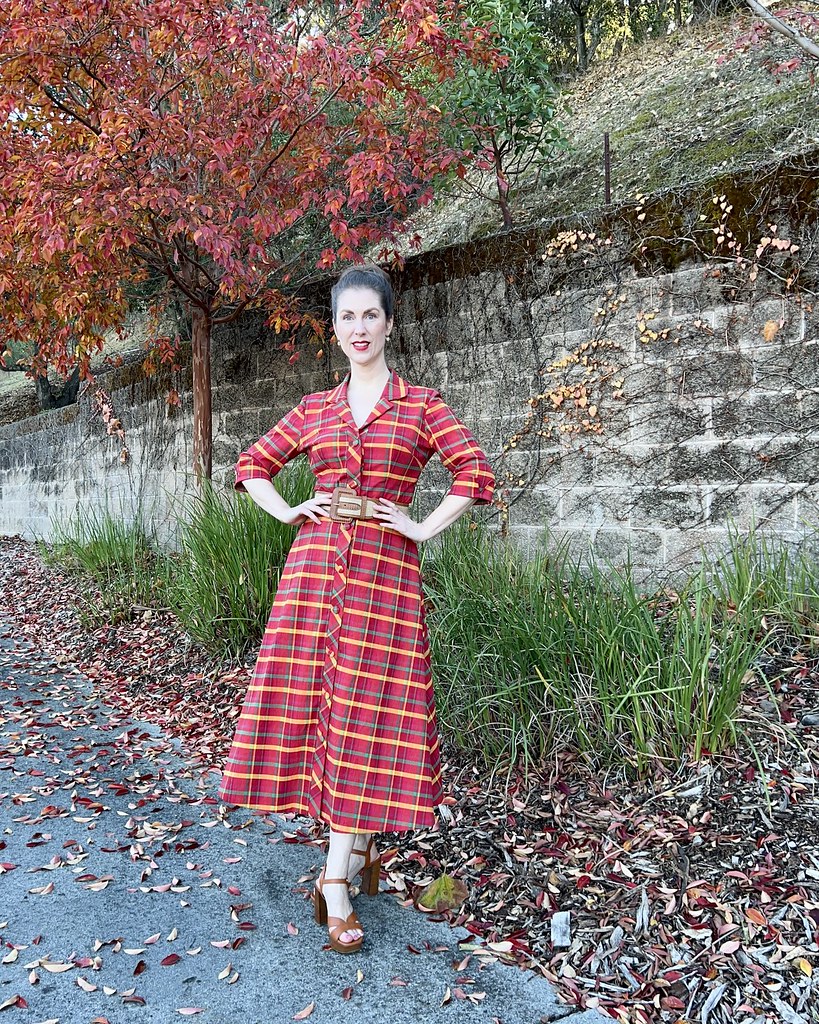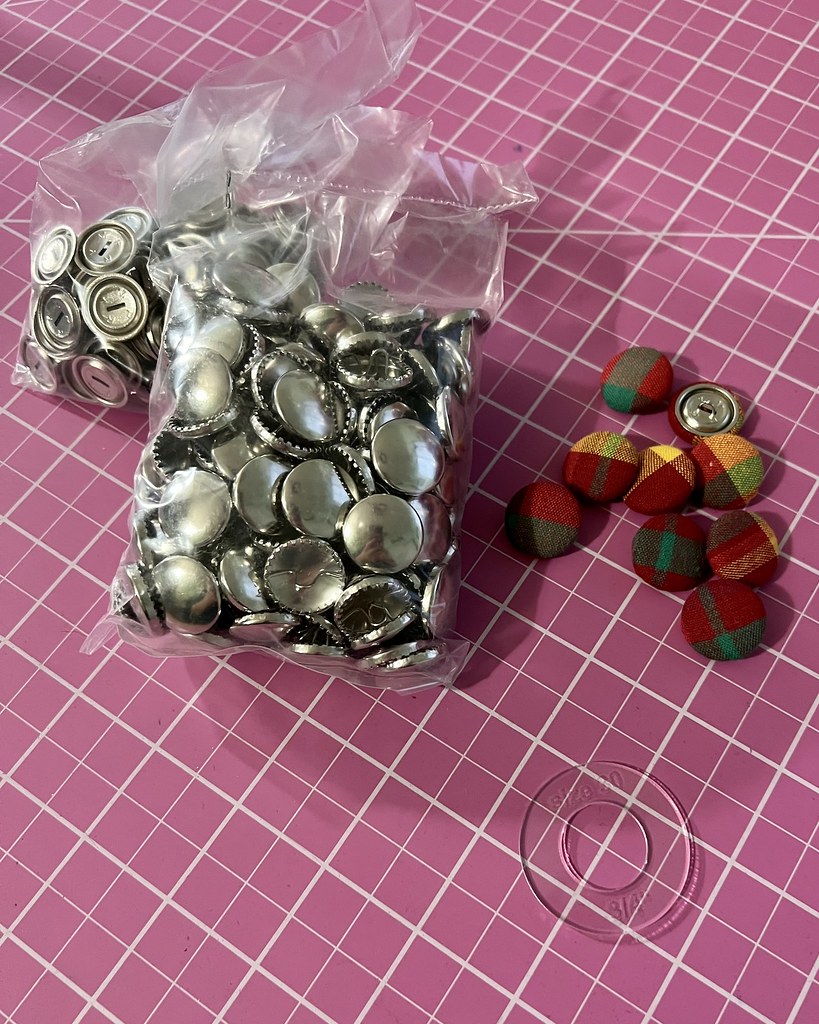This dress doesn't look too complicated, and quite frankly, it shouldn't have been . . . but a combination of being distracted and rather crabby over the last few weeks created an environment in which quite a few silly mistakes were made that meant that I had to do some creative work arounds.
Vogue 1965 is a recent vintage reproduction release, and I was rather interested in the back view of that gown. Of course, I have no need for a floor length sleeveless formal at the moment, but I thought I could add a bit of drama to the shorter version.
And somewhere along the way, I decided that it would make a nice Christmas frock. I wanted the shorter skirt, but I did love that drape back and the scooped out neckline, so I was going to swap those pieces in. Of course, all of this was dependent on having enough yardage, and I was cutting it close with this cut.
I stabilized the neckline with seam binding. This may not have been necessary, but I didn't want the back neckline to stretch out, and this will keep that from happening.
I ended up lining the bodice with a cotton voile remnant that I found stashed away. This makes is easy to trim away that princess seamline without hesitation since it's going to be covered with a lining.
The facing was interfaced and the edge finished with my standard seam binding.
And for whatever reason, the instructions suggest finishing the sleeve hem prior to installing the lined sleeves in the garment. So I went with it.
So far, so good.
It's giving a very classic 1960s shape, and I'm not mad about it.
Because I was expecting to wear some kind of tights with this dress, I decided to underline the skirt with a bemberg rayon. And let me tell you, finding enough black bemberg in the stash was a challenge. I have quite a few scraps, but these skirt pieces took a bit of a creative layout to fit. Which begs the question - why am I keeping all of those small scrap pieces?!
Part of the problem is that extra length from the waist to under the bust - I am used to cutting knee length skirts that sit at the waist.
And then came my biggest mistake. [The first was that I actually had to draft a back facing for this garment since the scooped back goes with the sleeveless version that is self-lined and doesn't have a facing . . . but I wasn't paying attention and cut out the given facing which obviously wasn't going to work. And there went more of my scarce fabric.] But I was rather determined to add that back drape. I would have been fine if I didn't start cutting out that drape using the foldline as a grainline. In my defense, the foldline for this piece is a multi-sized edge, which is not very common in Vogue patterns. Then again, I should know better. I stopped cutting as soon as I realized my mistake, but the damage was done - that large pattern piece was never going to fit on my meager remaining fabric.

But the main reason for my pattern choice was that lovely pseudo-Watteau-backed 1960s design, and I was pretty cranky about making another mistake with this dress. Readjusting the pattern piece left me with quite a bit of fabric missing from the lower edge; too much to get folded up in to a hemline.
But I did plan to use some leftover red velveteen for the under-bust contrast, and it struck me that the same contrast might work on that lower edge of the drape.
Unfortunately, there was significantly less of the velveteen than I remembered having . . . but a center seam solved that problem.
It wasn't perfect, but it might just save that back drape.
The piece gets folded, stitched down to the underlining, and attached at the lower bodice/upper skirt seam.
The red contrast on the drape is wider than the band on the bodice, but I was hoping that the proportions would work (it had to be wide enough to cover the cutting mistake, but still fit on the velveteen scraps, and I was hoping for the best).
The design calls for a side zipper, which I applied by hand with a lapped application.
And as long as there are no other crazy mistakes, this looks like it's coming together.
I was still uncertain about that back contrast at this point, but I was pretty sure that after I added the contrast band to the bodice, this would look much more balanced.
Because it's just so much more interesting with that extra skirt piece back there!
To keep the underlining layer in place along the hemline, I ran a line of stitches just inside the fold - this keeps the two different fabrics from separating. It also gives me an easy mark to follow for the actual hemline.
According to the instructions, the bottom of the panel is hemmed, and the sides just fold into place over that finished hem.
Most contemporary patterns would have the contrast band stitched right into the under bust seamline, but the original vintage instructions have the bias strip finished before hand stitching it along the seam.
This is helpful to eliminate some of the bulk that would otherwise be stuck in the zipper opening. I definitely prefer this manner of adding a contrast belt and bow.
It all means that you can choose the exact placement exclusive of the seamline; if you want the band to cheat slightly higher or lower, you can do that with this technique. That won't work if the raw edges are already enclosed within the seam.
For the skirt hem, I used some seam binding, per usual.
And for the finish at the contrast band, I did something a bit different than the instructions. They would have the contrast hand stitched along both short ends. But with such an obvious contrast, that would mean that the zipper would break up that line. Instead, I added some length to the bias piece and had the excess overhang the front bodice. This flap then gets snapped into place on the back bodice once the zipper has been closed.
And that seamline right in the center the red velveteen was still bothering me . . . so I scraped together the remaining scraps and made myself a bow to slap right over that aggravating seam. It's a lot, but this is a holiday dress, so I'm just going for it.
Do I still prefer a fluffy petticoated skirt? Yes. I probably always will. But every once in a while, it's good to switch things up a bit.
And yes, that double bow is rather silly. But I had velveteen scraps that are a lot more fun to have on this dress than folded up in a remnant bin. I can't actually believe that I managed to get a second bow out of the bits - it's almost as though it was meant to be.
That's another Christmas themed novelty printed dress for the collection. It won't get worn this year, but there's always next December.
And if I ever have the need for a floor length 1960s inspired gown, I know where to start.
Perhaps I will even add velveteen to next year's possible holiday textile choice . . . if I think I have the patience. Because it's not half as terrible as working with silk velvet!











































































